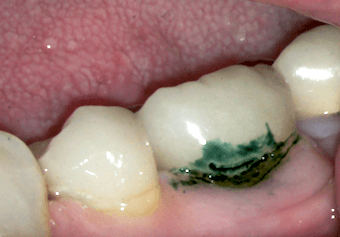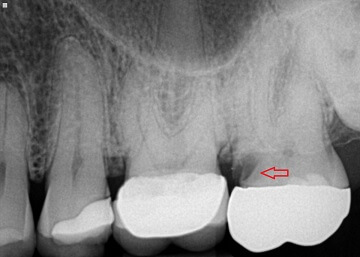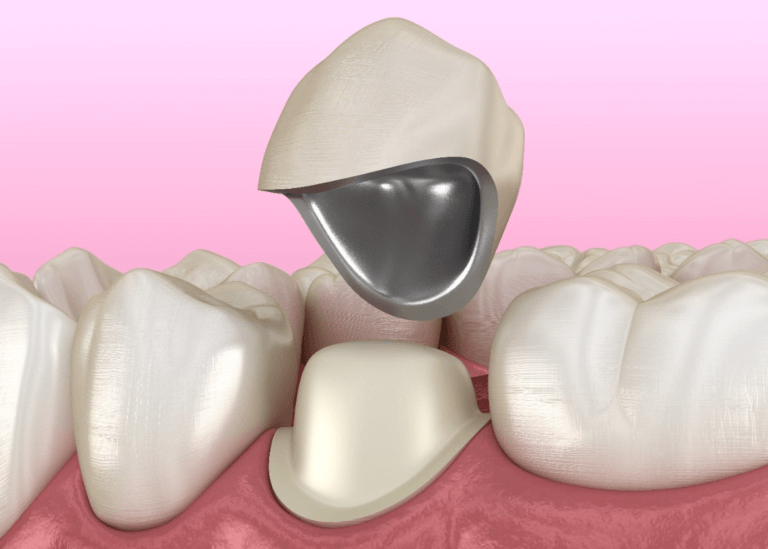A Cavity Under A Crown

What Is A Cavity Under A Crown?
A cavity under a crown refers to tooth decay that develops beneath a dental crown. Dental crowns are protective caps placed over damaged or decayed teeth to restore their shape, size, and function. While crowns are designed to safeguard teeth, they aren’t invincible. Over time, bacteria can accumulate at the base of the crown, leading to decay beneath it. This can cause tooth sensitivity, pain, and even infection. If left untreated, the cavity can severely damage the underlying tooth and nearby structures, making timely dental care essential.
If you think you have a cavity under a crown, here’s what you need to know:
- Why Do I Have A Cavity Under A Crown?
- Signs And Symptoms Of A Cavity Under A Crown
- Treatment Options For A Cavity Under A Crown
- Managing A Cavity Under A Crown Until You Can See The Dentist
- Cavity Risk Self Quiz
- Frequently Asked Questions About Cavities Under a Crown
If you have questions about A Cavity Under A Crown or other dental problems, please contact us for more information.
Why Do I Have A Cavity Under A Crown?
Cavities under crowns can develop for several reasons:
- Poor Oral Hygiene: Failing to brush and floss properly allows bacteria to build up around the crown’s base, leading to decay.
- Aging Crowns: The cement securing the crown may wear down over time, creating gaps where bacteria can enter and cause decay.
- Wear and Tear: Crowns can become damaged or cracked, allowing bacteria to seep in.
- Improper Fit: A crown that doesn’t fit snugly can leave spaces where bacteria and plaque can accumulate.
- Diet: A diet high in sugar and carbohydrates can accelerate decay around the crown.
It’s important to care for your crown as you would your natural teeth. Brush and floss regularly and see your dentist for checkups to avoid cavities under crowns. If you have further questions about A Cavity Under A Crown, please contact us.

Signs And Symptoms Of A Cavity Under A Crown
If you have a cavity under your crown, you may experience some of these symptoms:
- Tooth Sensitivity: Pain or sensitivity to hot, cold, or sweet foods and beverages.
- Tooth Pain: Persistent or intermittent toothaches, especially when biting or chewing.
- Gum Swelling: Swelling or redness near the gum line around the crown.
- Bad Breath: Persistent bad breath or a bad taste in your mouth.
These symptoms could indicate that decay has developed under your crown, and it’s important to seek dental treatment promptly to prevent more serious complications like infection or tooth loss. If you have further questions about A Cavity Under A Crown, please contact us.
Treatment Options For A Cavity Under A Crown
Once your dentist identifies a cavity under a crown, they may suggest one of the following treatment options:
- Crown Replacement: If the decay is extensive, the existing crown may need to be removed and replaced with a new one to properly seal the tooth.
- Root Canal Therapy: If the decay has reached the tooth’s pulp, a root canal may be necessary to remove infected tissue and save the tooth.
- Filling or Bonding: For minimal decay, your dentist may remove the cavity and fill or bond the area to prevent further damage.
Your dentist will determine the best course of treatment based on the severity of the decay and the condition of the tooth. If you have further questions about treatment options for A Cavity Under A Crown, please contact us.

Managing A Cavity Under A Crown Until You Can See The Dentist
If you suspect you have a cavity under your crown and can’t see your dentist right away, here are a few steps to manage the situation:
- Maintain Oral Hygiene: Gently brush and floss around the crown. You can also rinse with warm salt water or mouthwash to reduce bacteria and alleviate discomfort.
- Avoid Certain Foods: Stay away from sugary or acidic foods that could worsen the decay.
- Over-the-Counter Pain Relief: Medications like Advil (ibuprofen) or Tylenol (acetaminophen) can help manage pain. Follow dosing instructions, and don’t exceed the recommended dose. For severe pain, a combination of 600 mg ibuprofen and 1,000 mg acetaminophen every 4 to 6 hours may provide relief (but check with your healthcare provider first).
These tips can help manage your symptoms, but remember they are temporary measures—professional dental care is necessary to treat the cavity effectively. If you have further questions about treatment options for A Cavity Under A Crown, please contact us.
Cavity Risk Self Quiz
Try Our free online dental caries risk assessment quiz based on the California Dental Association’s Caries Management by Risk Assessment (CAMBRA) designed for patients aged 6 years and older. This caries risk assessment tool is meant to give you an idea of your level of dental caries risk, and by no means substitute for an oral exam by a dental professional. Please contact us for a more complete examination.
Frequently Asked Questions About Cavities Under a Crown
- How can a cavity form under a crown?
Cavities can develop if bacteria seep under the crown due to gaps, cracks, or poor oral hygiene. This often occurs at the crown’s edge where it meets the natural tooth.
- Can a cavity under a crown be fixed without removing the crown?
In some cases, minor cavities near the edge of a crown can be treated without removing it. However, larger cavities typically require crown removal to address the decay properly.
- How do dentists detect a cavity under a crown?
Dentists use bitewing X-rays and a clinical examination to check for decay beneath a crown. In some cases, specialized tools are used to assess the integrity of the crown and tooth.
- Will fixing a cavity under a crown weaken the tooth?
In some cases, the tooth may require additional support, such as a new crown or a post and core, to restore its strength. Your dentist will recommend the best approach to maintain durability.
Cavities under crowns can compromise the health of the underlying tooth if not addressed promptly, but early detection and treatment can save the tooth and restore the crown. Contact us for more information about cavities under crowns.

